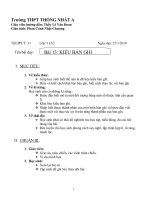Tài liệu Lecture 13: Communication Basics: pdf
Bạn đang xem bản rút gọn của tài liệu. Xem và tải ngay bản đầy đủ của tài liệu tại đây (104.06 KB, 9 trang )
CSN200 Introduction to Telecommunications, Winter 2000 Lecture_13 Communication Basics
Communication Basics:
Signals:
Communication happens in the form of signals.
Signals are transmission of energy (mechanical, electrical or light) through appropriate
media.
A signal that is constant and changed once conveys single information.
The more changes in the signal, the more information that the signal can convey.
For example, a push can mean one thing and removing it can mean another thing.
But how do we send more information than just these two?
We can do that by varying the amplitude, i.e., a strong push or a light push could have two
different meaning.
Or, a rate of change of push, i.e. 10 pushes per minute or 1 push per minute could have different
meaning too.
Or, even phase, i.e., pushing at a different angle could have different meaning too.
Amplitude, frequency and phase are the attributes of a signal that changes with time.
This pushing, transfer of mechanical energy has a limit. How many different amplitude, rate and
phase of pushing can we transmit and distinguish (receive)? God gave us organs like vocal cord
which can create higher rate of pushing and ears to sense that.
Higher the rate of pushing the more information it can convey and even the mixing of these
different rate could mean different information. And our vocal cord is able to do that as well.
We have even media (air) which will carry that signal far, so we don't have to stay close to
communicate. But that has a limit too.
Then we came out with a solution of converting this pressure wave to electrical signals and then
transmitting over long distances.
Signals can exists in different forms and transmit over different media. For example,
acoustic (pressure waves), electrical, electromagnatic and light signals.
Transducers:
Different signals and media have their own limitations. So according to need we change signals
to different forms.
The devices that convert signals from one form to another are called transducers.
In general, human do not generate electrical signals, nor do they respond to that or any other
form of signals except acoustic signals.
Human generate acoustic signals (speech) for communication. But to send that signal far we
need to convert that signal to the electrical form.
Lecture 13.doc Page 1 (9)
CSN200 Introduction to Telecommunications, Winter 2000 Lecture_13 Communication Basics
Transducers that convert acoustic signals into electrical signals are called microphones.
Transducers that convert electric signals into acoustic (sound) signals are called speakers.
Microphones:
Carbon microphone - used in telephones
Moving coil microphones - public address systems
Moving magnet microphones - public address systems
Piezoeletric microphones -
Capacitor microphones - Newer telephones, home audio systems
Speakers:
Moving coil speakers - public address systems
Piezoeletric speakers - Newer telephones, toys
Lecture 13.doc Page 2 (9)
CSN200 Introduction to Telecommunications, Winter 2000 Lecture_13 Communication Basics
Transducers converting electrical signals to light lignals:
Infrared diode - generates infrared light signals from electrical light signals, used in infrered
transmitters (remote control uinit).
Photo diode - generates electrical signals from infrared light signals, used in infrered
receivers (controled uinit, e.g., TV).
We also use these two in a pair to isolate two electrical circuits to reduce noise, and they are
called couplers.
Similar devices are laser diodes and detectors.
The Electromagnetic signals:
Information (voice, data, image, video) can be represented by electrical or electromagnetic
signals and transmitted over a suitable transmission medium.
Information can be transmitted on wires by varying some physical properties such as voltage or
current.
Transmitter/
Receiver
Transmitter/
Receiver
Information
Transmission
medium
An electromagnetic signal is a function of time, but it can also be expressed as a function of
frequency.
The frequency-domain view of a signal is far more important to an understanding of data
transmission than a time-domain view.
The characteristics and quality of a data transmission are determined by both the characteristics
of the medium and the characteristics of the signal.
Time-domain concept:
Viewed as a function of time, an electromagnetic signal can be either analog or digital.
An analog signal is one in which the signal intensity varies in a smooth fashion over time. There
are no breaks or discontinuities in the signal.
A digital signal is one in which the signal intensity maintains a constant level for some period of
Information
Electromagnetic
signal
Lecture 13.doc Page 3 (9)
CSN200 Introduction to Telecommunications, Winter 2000 Lecture_13 Communication Basics
time and then changes to another constant (discrete) level.
Analog
Time, t
Signal
Amplitude,
A
Digita
Time, t
l
Signal
Amplitude,
A
These signals can be of two type:
1. periodic, in which the signal pattern repeats over time. e.g., Sine wave and square wave.
2. non-periodic, in which the signal pattern does not repeat over time.
The sine wave is the fundamental analogue signal and it has three parameters:
1. Amplitude (A), strength of the signal over time, volts, current.
2. Frequency (f), is the rate at which the signal repeats. Cycles per second, or Hertz.
An equivalent parameter is period (T), is the amount of time for one repetition, ( T = 1/f ).
3. Phase (φ), is a measure of the relative position in time within a single period of a signal.
The general sine wave can be written as:
S(t) = A sin(2πft + φ)
Lecture 13.doc Page 4 (9)
CSN200 Introduction to Telecommunications, Winter 2000 Lecture_13 Communication Basics
Amplitude: Frequency:
Phase:
Lecture 13.doc Page 5 (9)









